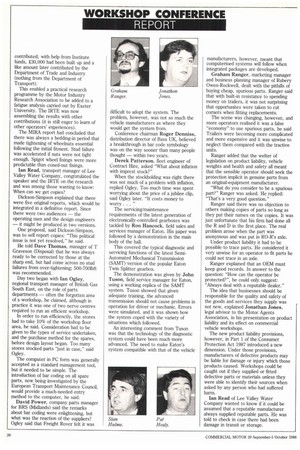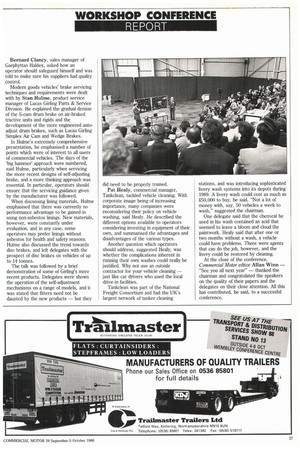WORKSHOP CONFERENCE REPORT
Page 22

Page 23

If you've noticed an error in this article please click here to report it so we can fix it.
contributed; with help from Institute funds, £30,000 had been built up and a like amount later contributed by the Department of Trade and Industry (nothing from the Department of Transport).
This enabled a practical research programme by the Motor Industry Research Association to be added to a fatigue analysis carried out by Exeter University. The IRTE was now assembling the results with other contributions (it is still eager to learn of other operators' experiences).
The MIRA report had concluded that there was always a bedding-in period that made tightening of wheelnuts essential following the initial fitment. Stud failure was accelerated if nuts were not tight enough. Spigot wheel fixings were more predictable than coned-nut fixings.
Ian Read, transport manager of Lee Valley Water Company, congratulated the speaker and the IRTE on the research and was among those wanting to know: When can we get copies?
Dickson-Simpson explained that there were five original reports, which would be integrated in a definitive report. Since there were two audiences — the operating men and the design engineers — it might be produced in two versions.
One proposal, said Dickson-Simpson, was to sell report copies: "This political issue is not yet resolved," he said.
He told Dave Thomas, manager of T Graveson (Disposal) that he was always ready to be corrected by those at the sharp end, but had come across no stud failures from over-tightening; 500-7001bft was recommended.
Day two began with Ian Ogley, regional transport manager of British Gas South East, on the role of parts departments — often the forgotten area of a workshop, he claimed, although in practice it was one of two nerve centres required to run an efficient workshop.
In order to run efficienctly, the stores had to take 10% of the workshop floor area, he said. Consideration had to be given to the types of service undertaken, and the purchase method for the spares, before design layout began. Too many stores stocked parts "just in case," said Ogley.
The computer in PC form was generally accepted as a standard management tool, but it needed to be simple. The introduction of bar coding on all spare parts, now being investigated by the European Transport Maintenance Council, would provide a much-needed entry method to the computer, he said.
David Power, company parts manager for BRS (Midlands) said the remarks about bar coding were enlightening, but what was the reaction of the suppliers? Ogley said that Freight Rover felt it was difficult to adopt the system. The problem, however, was not so much the vehicle manufacturers as where they would get the system from.
Conference chairman Roger Denniss, distribution director of Bass UK, believed a breakthrough in bar code symbology was on the way sooner than many people thought — within two years.
Derek Patterson, fleet engineer of Contract Hire, asked "What about inflation with imprest stock?"
When the stockholding was right there was not much of a problem with inflation, replied Ogley. Too much time was spent worrying about the price of a jubilee clip, said Ogley later. "It costs money to worry.
The servicing/maintenance requirements of the latest generation of electronically-controlled gearboxes was tackled by Ron Hancock, field sales and services manager of Eaton. His paper was followed by a demonstration in the main body of the hall.
This covered the typical diagnostic and servicing functions of the latest SemiAutomated Mechanical Transmission (SAMT) version of the popular Eaton Twin Splitter gearbox.
The demonstration was Oven by John Tuson, field service manager for Eaton, using a working replica of the SAMT system. Tuson showed that given adequate training, the advanced transmission should not cause problems in operation for driver or mechanic. Errors were simulated, and it was shown how the system coped with the variety of situations which followed.
An interesting comment from Tuson was that the technology of the diagnostic system could have been much more advanced. The need to make Eaton's system compatible with that of the vehicle manufacturers, however, meant that computerised systems will follow when integrated packages are developed.
Graham Ranger, marketing manager and business planning manager of Rubery Owen-Rockwell, dealt with the pitfalls of buying cheap, spurious parts. Ranger said that with built-in resistance to spending money on trailers, it was not surprising that opportunites were taken to cut corners when fitting replacements.
The scene was changing, however, and more operators realised it was a false "economy" to use spurious parts, he said Trailers were becoming more complicated and more expensive and it was unwise to neglect them compared with the tractive units.
Ranger added that the welter of legislation on product liability, vehicle weights and health and safety all meant that the sensible operator should seek the protection implicit in genuine parts from an original-equipment manufacturer.
"What do you consider to be a spurious part?" Ranger was asked. He replied: "That's a very good question."
Ranger said there was no objection to others making copies of parts so long as they put their names on the copies. It was just unfortunate that his firm had done all the R and D in the first place. The real problem arose when the part was anonymous and was put in RO-R's axle.
Under product liability it had to be possible to trace parts. He considered it very unwise for an operator to fit parts he could not trace in an axle.
Ranger explained that an OEM must keep good records. In answer to the question: "How can the operator be protected?", he could only suggest: "Always deal with a reputable dealer."
The idea that businesses should be responsible for the quality and safety of the goods and services they supply was not new, explained Jonathan Jones, legal advisor to the Motor Agents Association, in his presentation on product liability and its effect on commercial vehicle workshops.
The new product liability provisions, however, in Part 1 of the Consumer Protection Act 1987 introduced a new dimension. Under those provisions, manufacturers of defective products may be liable for damage or injury which those products caused. Workshops could be caught out if they supplied or fitted defective parts or materials unless they were able to identify their sources when asked by any person who had suffered harm.
Ian Read of Lee Valley Water Company wanted to know if it could be assumed that a reputable manufacturer always supplied reputable parts. He was told to check in case there had been damage in transit or storage. Bernard Clancy, sales manager of Garphyttan Haldex, asked how an operator should safeguard himself and was told to make sure his suppliers had quality control.
Modern goods vehicles' brake servicing techniques and requirements were dealt with by Stan Hulme, product service manager of Lucas Girling Parts & Service Division. He explained the gradual demise of the S-cam drum brake on air-braked tractive units and rigids and the development of the more engineered auto adjust drum brakes, such as Lucas Gilding Simplex Air Cam and Wedge Brakes.
In Huhne's extremely comprehensive presentation, he emphasised a number of points which were of interest to all users of commercial vehicles. The days of the 'big hammer' approach were numbered, said Hulme, particularly when servicing the more recent designs of self-adjusting brake, and a more thinking approach was essential. In particular, operators should ensure that the servicing guidance given by the manufacturer was followed.
When discussing lining materials, Hulme emphasised that there was currently no performance advantage to be gained in using non-asbestos linings. New materials, however, were constantly under evaluation, and in any case, some operators may prefer linings without asbestos for health and safety reasons. Hulme also discussed the trend towards disc brakes, and left delegates with the prospect of disc brakes on vehicles of up to 14 tonnes.
The talk was followed by a brief demonstration of some of Girling's more recent products. Delegates were shown the operation of the self-adjustment mechanisms on a range of models, and it was stated that fitters need not be daunted by the new products — but they
did need to be properly trained.
Pat Healy, commercial manager, Tankclean, tackled vehicle cleaning. With corporate image being of increasing importance, many companies were reconsidering their policy on vehicle washing, said Healy. He described the different options available to operators considering investing in equipment of their own, and summarised the advantages and disadvantages of the various types.
Another question which operators should address, suggested Healy, was whether the complications inherent in running their own washes could really be justified. Why not use an outside contractor for your vehicle cleaning — just like car drivers who used the local drive-in facilities.
Tankclean was part of the National Freight Consortium and had the UK's largest network of tanker cleaning stations, and was introducing sophisticated livery wash systems into its depots during 1989. A livery wash could cost as much as £50,000 to buy, he said. "Not a lot of money with, say, 50 vehicles a week to wash," suggested the chairman.
One delegate said that the chemical he used in his wash contained an acid that seemed to leave a bloom and cloud the paintwork. Healy said that after one or two months without a wash, a vehicle could have problems. There were agents that can do the job, however, and the livery could be restored by cleaning.
At the close of the conference, Commercial Motor editor Allan Winn — "See you all next year" — thanked the chairman and congratulated the speakers on the quality of their papers and the delegates on their close attention. All this has contributed, he said, to a successful conference.
















































